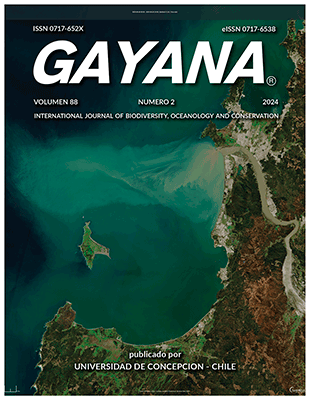Abstract
The Gulf of Arauco is the most productive and largest bay in central-south Chile. Soft bottom sublittoral coastal benthic macrofauna was studied in October 2021, January and August 2022, spanning from the Biobío River to Punta Lavapié. 118 taxons were identified for the three periods at the 21 sampling sites. The most abundant group was Polychaeta, with its most important species being Mediomastus branchiferus, Prionospio peruana, Aricidea pigmentata, Owenia sp., and Paraprionospio pinnata. Multivariate analysis found significant differences between the three studied periods. 5 spatial assemblages were identified in spring, 3 in summer, and 8 in winter. P. peruana, Goniada uncinigera, and Heterophoxus sp. were the most abundant taxons in spring; P. pinnata, Diopatra chilensis, and Cancer plebejus in summer; and M. branchiferus, A. pigmentata, and P. peruana in winter. Owenia sp. and P. pinnata were present at all sampling sites in the three periods. The northern and southern zones of the Gulf of Arauco showed greater similarities in relation to the central-northern zone, which also exhibited dissimilar taxonomic sub-assemblages for each sampling period. The study sites were associated according to Redox potential, total organic carbon, and sediment grain size variables. Temporal changes in multivariate community structure, the presence of very abundant, rare, and spatially widespread species in the Gulf of Arauco can be explained from an integrated metacommunity approach under the mechanisms of patch dynamics, species sorting, mass effects, and neutral.

This work is licensed under a Creative Commons Attribution-NonCommercial 4.0 International License.
Copyright (c) 2024 Eduardo Hernández-Miranda, Rodrigo Veas, Patricio Torres-Ramírez, M. Cristina Krautz, Aldo Hernández, Cristian Chandía, Marco Salamanca

